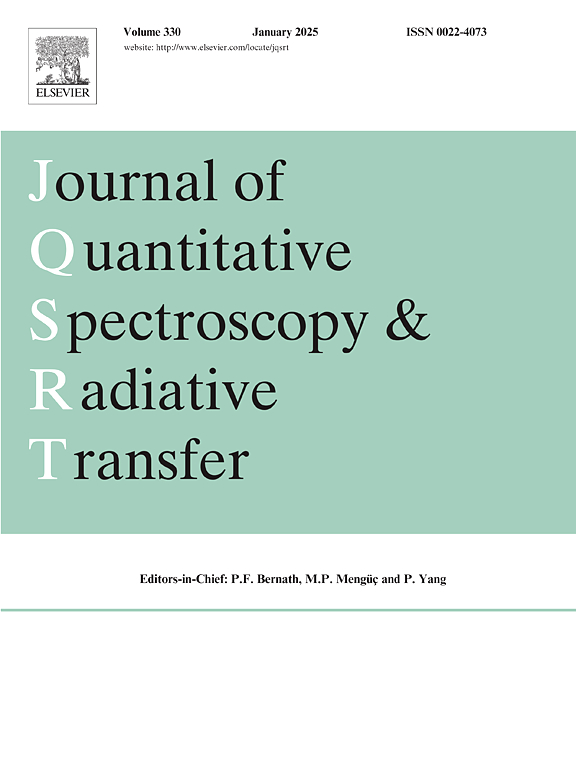碳纳米管涂层的光热发射率增强热废物管理
IF 2.3
3区 物理与天体物理
Q2 OPTICS
Journal of Quantitative Spectroscopy & Radiative Transfer
Pub Date : 2025-04-23
DOI:10.1016/j.jqsrt.2025.109488
引用次数: 0
摘要
高光吸收涂层是工业应用中光子转化为热量的关键因素,特别是在热光伏(TPV)系统中。碳纳米管(CNTs)由于其特殊的熔点、优越的光学吸收性和高效的热发射特性,在这些应用中仍然是一种很有前途的材料。在这里,我们提出了经过退火处理的碳纳米管阵列,评估了实验样品和基于文献中报道的性能的数值模型,以提出作为TPV系统中的吸收/发射器涂层。利用光热离子发射实验评价了实验样品的热稳定性,揭示了退火温度对其稳定性的直接影响。在模拟太阳辐照水平的情况下,分析了激光的光热瞬态特性。利用热方程预测了与光能传递相关的诱导效应的行为。考虑纳米结构的维数差异,分析了涂层的光学性能,确定了热发射光谱。基于碳纳米管涂层的结果,我们提出了一种既能抑制热辐射又能发电的TPV电池。在理想条件下,TPV系统在700 K到1500 K的温度下,效率分别为7%到11%。研究表明,增强型CNTs涂层可显著提高光热活性,并为不同工业部门的应用提供了一种管理热废物的手段。本文章由计算机程序翻译,如有差异,请以英文原文为准。

Photothermal emissivity of carbon nanotubes coatings for enhanced thermal waste management
High-optical-absorbance coatings are key contributors to the conversion of photons into heat for industrial applications, particularly in thermophotovoltaic (TPV) systems. Carbon nanotubes (CNTs) remain a promising material for these applications due to their exceptional melting point, superior optical absorbance, and efficient thermal emittance properties. Here we present CNTs arrays subjected to an annealing process, evaluating both experimental samples and numerical models based on properties reported in the literature, to proposed as absorb/emitter coatings in a TPV system. The thermal stability of the experimental samples was evaluated using a photo-thermionic emission experiment, which revealed the direct impact of the annealing temperature on their stability. The photothermal transient characteristics were analyzed considering a laser beam to simulate irradiances levels comparable to the solar radiation. The heat equation was employed to predict the behavior of the induced effects associated with optical energy transference. The optical properties of the coatings were analyzed considering differences in the dimensionality of the nanostructures to determine the thermal emittance spectrum. Based on the results of the CNTs coating, we propose a TPV cell designed to hardness thermal radiation and generate electrical power. Under ideal conditions, the proposed TPV system demonstrates efficiency ranging from 7 % to 11 %, at temperatures from 700 K to 1500 K, respectively. The enhanced CNTs coatings were shown to significantly improve photothermal activity and offer a means to manage thermal waste for applications in different industry sectors.
求助全文
通过发布文献求助,成功后即可免费获取论文全文。
去求助
来源期刊
CiteScore
5.30
自引率
21.70%
发文量
273
审稿时长
58 days
期刊介绍:
Papers with the following subject areas are suitable for publication in the Journal of Quantitative Spectroscopy and Radiative Transfer:
- Theoretical and experimental aspects of the spectra of atoms, molecules, ions, and plasmas.
- Spectral lineshape studies including models and computational algorithms.
- Atmospheric spectroscopy.
- Theoretical and experimental aspects of light scattering.
- Application of light scattering in particle characterization and remote sensing.
- Application of light scattering in biological sciences and medicine.
- Radiative transfer in absorbing, emitting, and scattering media.
- Radiative transfer in stochastic media.

 求助内容:
求助内容: 应助结果提醒方式:
应助结果提醒方式:


